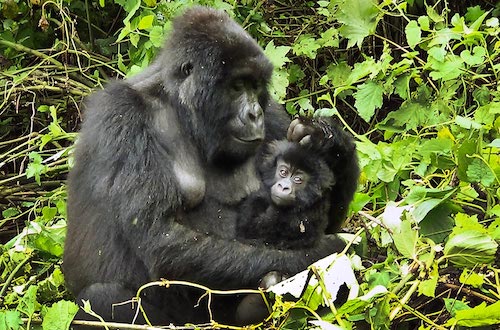Gorillas are among the most iconic and treasured animals in Africa. These majestic primates are native to a few select regions across the continent, and their populations, behaviors, and habitats have been the subject of much study, conservation effort, and fascination. When we speak of gorillas in Africa, a few specific countries often come to mind: Uganda, Rwanda, and the Democratic Republic of the Congo (DRC). These nations have played significant roles in the global recognition and fame of gorillas. But whose gorillas are more famous among these countries?
Rwanda: Mountain Gorillas in the Land of a Thousand Hills
 Rwanda is often the first country that comes to mind when thinking of gorilla trekking. This is largely due to its flagship national park, Volcanoes National Park. This park is home to the critically endangered mountain gorillas. Over the years, these gorillas have gained international acclaim, thanks in no small part to the groundbreaking work of Dr. Dian Fossey.
Rwanda is often the first country that comes to mind when thinking of gorilla trekking. This is largely due to its flagship national park, Volcanoes National Park. This park is home to the critically endangered mountain gorillas. Over the years, these gorillas have gained international acclaim, thanks in no small part to the groundbreaking work of Dr. Dian Fossey.
Fossey’s research and conservation efforts, which spanned nearly two decades, highlighted the dire situation of these great apes, threatened by poaching and habitat loss. Her dedication to the gorillas was immortalized in the book and film “Gorillas in the Mist.” Through her work, the gorillas of Rwanda became symbols of wildlife conservation.
Today, Rwanda’s gorilla tourism industry is a success story. The country has positioned itself as a luxury gorilla trekking destination, with permits fetching high prices, and the revenue largely reinvested into conservation and community initiatives.
Uganda: The Pearl of Africa’s Diverse Primate Habitats
 While Rwanda often takes the limelight for gorilla tourism, Uganda is home to a more significant number of these primates. Bwindi Impenetrable National Park and Mgahinga Gorilla National Park are the primary destinations for gorilla watchers in the country.
While Rwanda often takes the limelight for gorilla tourism, Uganda is home to a more significant number of these primates. Bwindi Impenetrable National Park and Mgahinga Gorilla National Park are the primary destinations for gorilla watchers in the country.
Uganda offers a diverse experience for tourists. Not only can visitors encounter mountain gorillas, but they also have the chance to see other primates like chimpanzees, especially in places like Kibale National Park.
Uganda’s approach to gorilla tourism is slightly different from Rwanda’s. It offers a broader range of experiences, from budget to luxury, making it accessible to a more diverse group of tourists. This has given Uganda a reputation as a more versatile gorilla trekking destination.
Democratic Republic of the Congo: The Wild Frontier
 The DRC is home to both mountain gorillas and their lowland relatives, the Grauer’s gorillas. Virunga National Park, Africa’s oldest national park, is the primary destination for mountain gorilla trekking in the DRC.
The DRC is home to both mountain gorillas and their lowland relatives, the Grauer’s gorillas. Virunga National Park, Africa’s oldest national park, is the primary destination for mountain gorilla trekking in the DRC.
The DRC’s gorillas have been embroiled in the country’s long-standing conflicts, with Virunga often being at the frontline. The park and its rangers have faced immense challenges from armed militias, poachers, and illegal charcoal production.
Despite this, the resilience and dedication of the park rangers and conservationists have been commendable. Their stories and the plight of the DRC’s gorillas were highlighted in the Netflix documentary “Virunga,” which brought international attention to the region.
While the DRC’s gorilla tourism industry isn’t as developed as Rwanda’s or Uganda’s due to ongoing security concerns, the raw and untamed nature of the experience in Virunga appeals to the adventurous spirit of many.
Conclusion: A Shared Fame
It’s challenging to definitively say whose gorillas are the most famous among these three countries. Each country has contributed uniquely to the global recognition and conservation of these incredible animals.
Rwanda has the legacy of Dian Fossey and a highly successful tourism model. Uganda offers diverse primate experiences and accessibility for different types of travelers. The DRC provides a wild and raw adventure while showcasing the frontline battle for conservation.
In the end, the fame of Africa’s gorillas isn’t restricted to national borders. Their story is a shared one, a testament to the dedication of countless individuals and communities across the continent, fighting to ensure that these magnificent creatures continue to roam the forests of Africa for generations to come.

